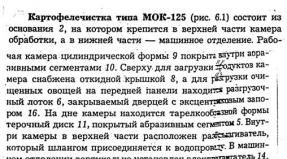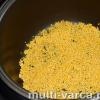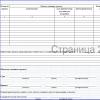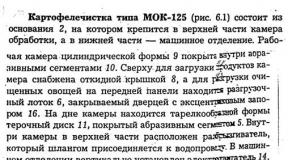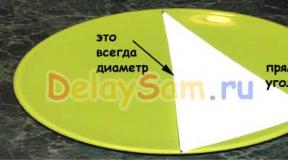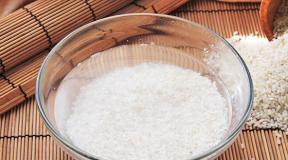Accounting for materials using account 10. Write-off of materials step-by-step instructions for accounting. Raw materials
Data on the availability and movement (distribution) of raw materials, spare parts, fuel, household supplies, containers, equipment and similar objects is summarized by account 10 in accounting classified as valuables. According to the article in question, among other things, information about items being processed and in transit is recorded. Let's take a closer look at account 10 in accounting: postings, specifics of data reflection.
General information
The chart of accounts establishes certain rules by which information on certain items is reflected. They are determined depending on the specifics of the enterprise’s activities. Account 10 “Materials” records raw materials in the following ways:
- Based on the actual cost of acquisition (procurement).
- At the discount price.
A slightly different scheme applies to enterprises producing agricultural products. Self-produced goods are recorded at planned cost. After the final reporting cost estimate is generated, it is adjusted to the actual cost estimate. When reflected at the average purchase price, purchase price (procurement), etc., the difference between the cost of objects is shown on the account. 16.
Account 10 in accounting: subaccounts
Additionally, articles can be opened:

Raw materials
Account 10.01 in accounting reflects information about the presence and movement of valuables included in the structure of manufactured products, forming their basis or acting as necessary components in production. It also reflects information about auxiliary facilities that are involved in the manufacture of products or are used for economic, technical purposes, to facilitate the production process. This article covers agricultural goods prepared for processing.
Semi-finished products, components, parts and structures
According to subaccount. 10.2 are purchased, ready-made objects purchased for completing manufactured products (construction). Such valuables require investment in their processing or assembly. Products purchased for assembly, the cost of which is not included in the cost of manufactured products, are recorded on the account. 41. Enterprises that are engaged in research, technological, and design work, purchasing fixtures, tools, special equipment and other devices as components from third-party companies, record them on the subaccount. 10.2.
Fuel
According to subaccount. 10.3 passes petroleum products (gasoline, kerosene, diesel fuel, oil, etc.), lubricants. They are intended for vehicle operation, heating and energy generation, as well as gaseous and solid (wood, coal, peat, etc.) fuel, and technological needs. If the enterprise uses coupons for petroleum products, they are also recorded according to the subaccount. 10.3.

Container objects
On subaccount 10.4 takes into account all types of containers, except those used as household equipment. This article covers parts and raw materials intended for the production of packaging and its repair. These, in particular, include barrel stave, parts for assembly, hoop iron, etc. Items that are intended for additional equipment of barges, wagons, ships and other vehicles to ensure the safety of transported products are taken into account according to the subaccount. 10.1. Trade enterprises record the presence and movement of containers (under goods and empty) on the account. 41.
Spare parts
They are shown by the subaccount. 10.5 (accounting account). This article covers parts purchased or produced to achieve the goals of the enterprise’s activities, intended to replace worn-out parts of machines, vehicles, equipment, and repairs. Information about car tires in circulation and stock is also reflected here. The article shows the movement of the exchange fleet of equipment, complete machines, units, components, engines, which is created in repair departments, factories, and technical points. Car tires (rim tape, tube, tire), which are in stock and on wheels on the vehicle, included in its initial cost, are transferred to the operating system.
Other items
On subaccount 10.6 reflect the presence and movement of:
- Industrial waste. These include, in particular, shavings, trimmings, stumps, and so on.
- An irreparable marriage.
- Scrap rubber and worn-out tires.
- Material assets that were received from OS, not intended for use as materials or spare parts. These include, for example, waste materials and scrap metal.
Industrial waste and secondary raw materials, which are used as solid fuel, are recorded on the subaccount. 10.3.

Outsourced objects
According to subaccount. 10.7 materials are processed, the cost of which will subsequently be included in the costs of manufacturing products obtained from them. The costs of the relevant operations paid to third parties and persons are included directly in the debit of the accounts in which the objects received after processing are recorded.
Other articles
Subaccount 10.8 is used by property developers. It carries materials that are used directly in the process of construction and installation activities, as well as in the manufacture of parts, construction and finishing of structures, parts of structures, buildings. On subaccount 10.8 also takes into account other items that are necessary for construction needs (for example, explosives). According to subaccount. 10.9 includes inventory, household supplies, tools and other objects that are included in working capital.
Additionally
The above articles are not all that can reveal account 10 in accounting. Sub-accounts are formed in accordance with the industry focus of the company. In particular, this is relevant for enterprises producing agricultural products. Additional subaccounts of article 10 can be created to reflect the movement and availability of:

Admission
The chart of accounts allows for the reflection of the receipt of raw materials according to the account. 15, recording the acquisition and preparation of mat. values or by account 16, showing the deviation in their value, as well as without their inclusion in the records. The choice will depend on the financial policy approved by the enterprise. When using the account. 15 and count. 16, in accordance with the calculation documentation received by the organization, an entry is made: Db 15 Kd 60 (20, 23, 71, 76, etc.).
Explanations
The credit of accounts will correspond to the sources of receipt of materials and the nature of expenses. An entry according to DB 15 and Kd 60 is made regardless of the time the enterprise received the objects - before or after acceptance of the settlement documentation. Capitalization is carried out on the account. 10. The chart of accounts includes in the record Cd account. 60. In this case, the valuables are not included in the warehouse. Their actual consumption in production or for other economic purposes is reflected in the CD account. 10 in correspondence with accounts for accounting for production/sales costs. Other relevant articles may also be used. To close account 10 in accounting, write-off, sale, gratuitous transfer and other disposal of objects are reflected at the corresponding cost on the DB account. 91. Analytics is carried out by storage locations of valuables and individual items (sizes, varieties, types, etc.).
Accounting: account 10 "Materials" (structure)
To understand the nature of the article, it is necessary to highlight a number of key points. First of all, the category itself, which is reflected by score 10, is subject to consideration - “materials”. They represent any objects from which, after processing, finished products are created. The accounting plan refers to them as values reflected in the property of the enterprise. Objects that are present in the organization, but which it does not legally own, are reflected in the account. 002 or 003. The decisive factor in determining the values that are included in account 10 in accounting is not the fact that they are in warehouses, but the existence of ownership rights to them.

Note
The above means that objects that may be exactly the same, lying in the same pile, are reflected differently. Objects to which ownership has been transferred, but are not present in warehouses, are included in account 10. In accounting, this category primarily includes objects in transit. The supplier handed over, for example, valuables to the railway station and ordered them to be transported to the buyer’s address. As soon as the cargo was accepted by the railway, it became the property of the acquirer (unless the contract provides otherwise). Theoretically, from this moment on, entries should be made in the buyer’s accounting records. But records are made only upon receipt of the appropriate documentation, which confirms the shipment dates.
Redirection of values
Objects may act as the property of an enterprise, but will never be delivered to its warehouses. For example, this occurs in cases when, on behalf of an organization from Moscow, a batch of raw materials is purchased in Vladivostok and, by its own order, it is resold to Novosibirsk. From the moment of purchase until shipment, the valuables are located in Vladivostok. Nobody saw them in Moscow. However, they were owned by the enterprise. In this regard, before the acquisition from Novosibirsk, entries must be made in the accounting records of the Moscow organization.
Recycling
Objects for which the enterprise retains ownership, but they are transferred to a third-party company for processing, are reflected in account 10. In accounting, entries in this case do not imply crediting the item. This circumstance follows from the principles of reporting. In particular, this refers to the fact that only those values that are owned by the enterprise can be reflected on the balance sheet. This principle, however, contradicts the position of priority of content over forms. It is accepted both in foreign practice and in domestic PBU 1/98. This principle instructs the specialist not to start from legal categories, but to focus on the actual state of affairs. For example, the customer's paper is present in the warehouse along with the company's own paper. There will be no difference regarding the financial responsibility of employees and the technology for further use of valuables. Both papers must be recorded in one article. But according to the Plan, the same values under the same financial responsibility will be taken into account in different accounts.

Posting
All received valuables, the ownership of which has transferred to the company, must be reflected in the DB account. 10. But in this case a number of questions arise. The first of them: what to do if the ownership of the enterprise has been transferred, but the accounting department does not know about it and cannot find out? There is a rule that no records are made without documentation. But if we are guided by IFRS standards, then as soon as the supplier has shipped the goods, a fax or electronic notification about the transaction must be sent to the specialist. In this case, the entry is made:
- db 10.
- Db 19 (VAT on purchased values).
- CD 60.
In this case, the company's reporting will show the real situation in the enterprise. In this case, the asset will reflect all goods that are owned by the company. The liability will show the actual accounts payable. But in this case, inventory of objects is complicated. It can be carried out using documentation of dubious legal force (faxes and similar papers). In the case under consideration, it is more correct to recognize the legal rather than the economic interpretation.
No prices in documents
After receiving settlement papers from the supplier, if a discrepancy is identified between the cost at which the objects were accepted and the amounts given in them, corrective entries are made. Traditionally, the amount indicated in the settlement documentation is reversed for uninvoiced deliveries. Account 10 in accounting is debited along with the account. 19. The account is credited. 60. But these records cannot in all cases be displayed in computer programs existing today. In this regard, account 10 in accounting is debited together with the account. 19 in correspondence with account. 60 for the difference between the cost given in the calculation documentation and the price at which the objects were accepted, if it is lower.

What to do if the purchase price is encumbered
If the enterprise does not use discount prices, materials are received according to the actual purchase price. In some companies, specialists include transportation and other costs that are included in the cost price in the purchase price. However, experts believe that this work is inappropriate. Since one accompanying document contains several names of objects, difficulties may arise when distributing total costs between individual types of values. There are many ways out of this situation. Distribution can be carried out proportionally:
- Cost.
- Transportation distances.
- Production significance (according to conditional, special and pre-established coefficients).
- Weight and so on.
However, with great labor intensity, such distributions are always conditional in nature, distort the purchase price, and, importantly, the variability of object valuations increases. In this regard, it would be most appropriate to concentrate all expenses related to the acquisition of valuables in the corresponding subaccount 10.10, which records transportation and procurement costs. At the end of the period, costs are distributed between the total balance of assets and the total cost of objects sent to production.
Formation of nomenclature
Three features of this process should be noted:
- The name is a group of values of a homogeneous purpose. For each unit of these objects, an unambiguous accounting value is established.
- Name - homogeneous raw materials with the same cost of receipt. In the accounting nomenclature, a number of positions is formed that corresponds to the number of varieties of prices for accepted values.
- A name is considered to be a group of objects of a similar purpose, the capitalization of which is carried out at the actual cost of receipt.
The last option acts as a compromise between the first two. However, in this situation, the problem arises of choosing specific prices at which the disposal materials are valued.

Important point
Clause 6 of Order No. 44 of the Ministry of Finance establishes a special procedure for the formation of the actual cost of assets that are purchased under contracts, the terms of which provide for the repayment of obligations in ruble amounts equivalent to prices in foreign currency. The enterprise's costs for the purchase of objects are determined taking into account the amount differences that arise before the inclusion of inventories in accounting. An important point needs to be mentioned here. Accounts payable and valuables are included in accounting at the same time. Perhaps in this case we mean reflecting objects directly according to the article in question, and not according to the account. 15. But this approach presupposes a special procedure for accounting for differences in amounts for uninvoiced supplies. In all other cases, deviations must be recorded on the account. 91 and do not form an assessment of the material costs of the enterprise.
Account 10 in accounting is necessary to collect data on the organization’s ownership of materials, as well as their movement. In this article we will talk about the features that need to be taken into account when using this account.
The concept of materials and their types
The rules for using account 10 “Materials” are regulated by the chart of accounts and instructions for it, approved by order of the Ministry of Finance of the Russian Federation dated October 31, 2000 No. 94n. Materials are a type of inventory that is intended for the manufacture of products or for the economic needs of an organization. The chart of accounts provides for 11 sub-accounts, formed by type of materials based on economic characteristics:
- Raw materials and materials that are the basis of manufactured goods and are necessary for the normal functioning of the enterprise.
- Purchased semi-finished products and components necessary for the production of products, for the use of which it is necessary to carry out additional work on them.
- Fuel used for heating, operating vehicles and other needs inherent in a production organization.
- Containers and packaging materials used for the production of containers.
- Spare parts that are necessary for the repair of fixed assets.
- Other materials generated as a result of defects, production waste, write-off of fixed assets, etc.
- Materials outsourced for processing, the cost of which is transferred to the cost of manufactured goods.
- Construction materials necessary for the developer's work.
- Inventory and household supplies that are working capital and used as means of labor.
- Special equipment and protective clothing in the warehouse.
- Special equipment and clothing in use.
Information on the use of each subaccount is available in the instructions for the chart of accounts. An organization can open other sub-accounts necessary for its specific needs. Receipt of materials is shown by the entry
Write-off of materials
When used, materials are written off as expenses by recording
Dt 20, 21, 23, 25, 26, 29, 44 Kt 10.
When materials are disposed of as a result of sale, donation, or write-off, they are included in other expenses:
Dt 91.2 Kt 10.
Results
Account 10 accumulates data on the organization's current assets. It depends on the specifics of the production which sub-accounts are appropriate to open for it. On account 10, accounting can be carried out both at actual and at accounting prices. In the second case, accounts 15 and 16 will also apply.
Balance sheet for account 10(hereinafter referred to as OSV) is necessary to ensure compliance with all requirements for analytics supported in the “Materials” account. Account 10 is one of the few that, according to the order of the Ministry of Finance from Russia 10.31.2000 No. 94n must be maintained by individual items and storage locations.
Description of account 10
This account is active. This means that the account balance can only be a debit balance, a credit balance is not allowed. The debit of the account reflects the receipt of materials, and the credit reflects the write-off (for example, for production, for sale).
All inventories with the same name and dimensional characteristics must have their own unique item number (code). This allows the material to be identically identified by different employees of the organization: supplier, storekeeper, accountant.
The organization must maintain records of materials at storage locations. This is due to the fact that the same material can be stored in different warehouses. As a rule, a storekeeper or other employee is responsible for the safety of materials in a warehouse, with whom a liability agreement must be concluded.
Important! The balance sheet for account 10, generated by warehouses, shows the balances of material inventories for each materially responsible person.
Key points when forming SALT on a count of 10
2 methods of analytical accounting of materials are discussed in great detail in Chapter. VII section 2 Methodological guidelines for accounting of industrial production, approved by order of the Ministry of Finance of Russia dated December 28, 2001 No. 119n. This document lays out the foundations on which you need to rely when organizing materials accounting. At the same time, it is necessary to make modern adjustments to the development of software products for accounting.
The main thing that must be taken into account when forming OSV:
- SALT is a summary report that should indicate:
- opening balance in quantitative and monetary terms;
- income in quantitative and value terms;
- consumption in quantitative and monetary terms;
- ending balance in quantitative and monetary terms.
- The SALT is first generated for each warehouse, then all statements for warehouses are collected into a consolidated SALT for the organization as a whole. Then, based on the summary report, synthetic accounting data is obtained, which is reflected in the reporting.
- Despite automated accounting, warehouse cards for materials accounting must be required. The posting of receipts and disposals in them is carried out by the financially responsible person in quantitative terms. A card is created for each item number.
- Primary documents on the movement of materials must be on paper, and they must have “live” signatures.
Checking SALT and warehouse data
Work with primary documents on the movement of materials in organizations can be structured in 2 directions:
- The primary document (for example, a demand invoice) is written out manually at the time the material is received or issued, signed and handed over to the accountant. The accountant enters data into the program, making entries in the appropriate accounts. In this case, the material code, the warehouse through which the movement took place, and balance sheet accounts must be correctly indicated.
- First, postings are made in the program, i.e. the movement of material is reflected, and then the primary document is printed, which must be signed by the persons participating in the business transaction.
We will not dwell on the pros and cons of each of these methods of reflecting and generating primary documents. Often it all depends on the software used in the enterprise. It is important to understand that in both cases the influence of the human factor is great. Data may be entered into the program using the wrong item number or warehouse. And this will lead to incorrect formation of OSV.
If the financially responsible person timely posts documents on the movement of materials in warehouse accounting cards, then at the end of the month he must have the correct balance for each item calculated. And when the WWS arrives from the accounting department to the warehouse, the storekeeper must check it with the data on the cards.
Important! It is necessary to reconcile the data of the OCB and the cards. This procedure will allow timely identification of discrepancies, finding their causes and, if necessary, making changes to accounting or warehouse records.
Balance sheet for account 10
Let us consider, using an example, the main points associated with the formation of the SALT, in particular, how the procedure for receipt and write-off of materials occurs and how these movements are reflected in the SALT.
Example
NTK LLC received materials from the supplier in November 2018 (at the beginning of the month there were already some leftover materials in its warehouse). Some of the inventory was written off for production, and some was sold. Materials are assessed at average cost.
Admission. NTK LLC received from the supplier TORG-12, invoice and materials:
|
Name |
Quantity |
Unit price, without VAT |
Code assigned to the material |
|
White enamel |
|||
|
Primer |
|||
|
Varnish for external works |
|||
|
Water based varnish |
Write-off. Based on the invoice requirement for production needs, the following was used:
|
Name |
Quantity |
Average unit cost |
Code assigned to the material |
|
Yellow enamel |
Implementation. The buyer was issued TORG-12 and an invoice:
SALT for November 2018:
Explanations for the tables:
1 Remaining: 100 kg x 60 rub. + receipt: 50 kg x 90 rub. Average cost of 1 kg: (100 x 60 + 50 x 90) / 150 kg = 70 rub.
2 There was no arrival. The average cost is equal to 7,500 / 15 = 500 rubles.
3 There was no arrival. The unit cost is calculated based on the balance: 2,000 / 10 = 200 rubles.
4 Remaining: 20 kg x 206 rub. + receipt: 100 kg x 200 rub. Average cost of 1 kg: (20 x 206 + 100 x 200) / 120 = 201 rub.
5 There was no arrival. The average cost is calculated based on the balance: 3,000 / 60 = 50 rubles.
6 The average cost of 1 kg is calculated as follows: (balance at the beginning: 50 kg x 95.20 rubles + receipt: 30 kg x 100 rubles) / 80 = 97 rubles. Remaining at the end: 80 kg x 97 rub. = 7,760 rub.
In this example, we considered a situation where receipts and expenses were made within the same warehouse. If there are several storage locations, a similar OSV must be generated for each.
In addition to being valued at average cost, units of material can also be valued at cost per unit and using the first-in, first-out (FIFO) method. More details about the assessment of materials upon disposal can be found in PBU 5/01 “Accounting for Inventory and Inventory” (Section III).
Results
It is difficult to imagine a production organization that purchases a small amount of material assets. The process of forming OSV itself is simple. The main problem is the variety of items, warehouses, materially responsible persons and a large volume of primary documents.
Several participants may be involved in the chains of acquisition and write-off of materials: a supplier, a storekeeper, workers or craftsmen who receive materials for production, and sales employees. The primary document can get lost at any stage of inventory movement and not reach the accountant. So, first of all, the accountant is interested in creating a document flow that will allow receiving primary data in a timely manner and in full.
Currently, SALTs are generated automatically, based on primary documents entered into accounting programs. However, do not forget that you need to oblige the storekeeper (or other materially responsible person) to keep warehouse records in quantitative terms (in cards or special journals). Then, discrepancies identified during reconciliation of accounting and warehouse data will help you find documents that did not reach the accountant or storekeeper.
Account 10 “Materials” is intended to account for the enterprise’s inventories (raw materials, fuel, spare parts, etc.).
The account is active, synthetic, and has several subaccounts. You can read about what types of accounts there are. In the context of an account, you can maintain analytical accounting by type of material and production assets.
TO account 10 “Materials” Sub-accounts can be opened:
- 10-1 “Raw materials and supplies”;
- 10-2 “Purchased semi-finished products and components, structures and parts”;
- 10-3 “Fuel”;
- 10-4 “Containers and packaging materials”;
- 10-5 “Spare parts”;
- 10-9 “Inventory and household supplies”;
- and others.
 The Debit of account 10 reflects any receipts of materials, and the Credit records their write-off (disposal).
The Debit of account 10 reflects any receipts of materials, and the Credit records their write-off (disposal).
The balance of account 10 “Materials” can only be debit, since the account is active!
I propose to consider the main typical transactions for account 10.
- Materials received from supplier D-10 K-60/76
- VAT is reflected on received materials D-10 K-60/76.
- Materials were received from the accountable person D-10 K-71.
- The materials contributed as a contribution to the authorized capital of D-10 K-75 have been capitalized.
- During the inventory, unaccounted materials were identified D-10 K-91
- Materials received as a result of the liquidation of fixed assets D-10 K-91 were capitalized
- Received materials donated by another organization D-10 K-98.
- Materials were written off for non-production needs (improving working conditions) - D-91 K-10.
- Materials from the production of D-10 K-20 have been returned.
- Materials for the construction of fixed assets D-08 K-10 were written off.
- Materials were written off for the main production of D-20 K-10.
- Materials were written off for auxiliary production D-23 K-10.
- The cost of materials is included in the cost of selling D-44 K-10.
- The cost of materials for victims of emergency situations (fire) was written off - D-99 K-10.
An enterprise has the right to write off materials for production using the following valuation methods:
- at the cost of each unit;
- (FIFO method);
- at the cost of the most recent purchases (LIFO method - not used since 2008).
The method must be selected and prescribed in the accounting policy.
Let’s solve a small problem to reinforce the topic:
A furniture production plant purchased 7 boards at a price of 100 rubles per m, excluding VAT. Charged for delivery of boards is 150 rubles, excluding VAT. The payment for materials and delivery was paid from the bank account. For the production of the cabinet, 3 boards were written off at the average cost.
Make postings.
Solution:
- Let's calculate VAT on boards = 700 * 0.18 = 126 rubles.
- Let's calculate VAT on transport costs = 150 * 0.18 = 27 rubles.
- Transport costs are evenly distributed among the boards.
- Let's calculate the amount of written-off boards using the average cost method: 850/7*3 = 364.29 rubles.
Let's make the wiring:
- Materials from the supplier D-10 K-60 were capitalized - 700 rubles.
- VAT is reflected on purchased materials D-19 K-60 - 126 rubles.
- Transport costs are reflected - D-10 K - 60 - 150 rubles.
- VAT is reflected on transport costs – D-19 K-60 – 27 rubles.
- Materials D-20 K-10 were written off for production - 364.29 rubles.
Accounting in enterprises and organizations plays quite an important role. Correct maintenance of all documentation related to the receipt of funds, their expenditure, loss, payment of wages, and so on allows us to determine How profitable is the activity being carried out?.
As is known, today there is a lot of manufacturing enterprises. When they work, one of the components becomes count 10. It should be noted that this bill refers to materials. The document is used to summarize all information that is related to the availability and movement of raw materials, fuel consumption, the purchase of spare parts for machinery and equipment, the purchase of inventory and household supplies.
Materials must be accounted for at their cost of purchase or procurement. In addition, it is necessary to take into account discount prices.
Those enterprises that work in the field of manufacturing agricultural products, products of their own production for the reporting year are most often reflected in account 10. In this case, throughout the entire working year, until the preparation of annual reports it should be taken into account in accordance with the planned cost. After the annual report on the operation of the enterprise has been compiled, the cost of the materials used must be slightly adjusted in order to reach the actual cost.
In the process of accounting at prices that are accounting, the difference between cost and cost must also be reflected in the corresponding account. It should be noted that the accounting value is influenced by the planned cost of acquisition, as well as average purchase prices.
The cost of production indicator depends on the correctness and timeliness of capitalization and write-off on account 10. In addition, in this case an important role is played the result of any type of activity. We are talking about profits as well as losses here.
 These item-type groups should include assets that are used for semi-finished products, raw materials, as well as components and other types of inventory-type assets. They are used in the production process of products, as well as the provision of services used for the own needs of an enterprise, company or organization.
These item-type groups should include assets that are used for semi-finished products, raw materials, as well as components and other types of inventory-type assets. They are used in the production process of products, as well as the provision of services used for the own needs of an enterprise, company or organization.
Highlight specific purposes for accounting:
- Security control process.
- Reflection of business-type transactions in accordance with the movement of inventory items (this is necessary in order to plan the cost of production, as well as carry out financial and managerial accounting).
- The process of cost formation.
- Control over standard reserves.
- Identifying what happened, any loss or damage to materials.
Subaccounts
Accounting provisions include list of many accounting accounts, which must be used in the process of accounting for materials, in accordance with classification, as well as item-type groups. Depending on the specifics of the work, as well as the accounting policies, the accounts can be completely different.
It should be noted that in this issue the form of ownership of the enterprise (budgetary or commercial), type of activity (production, sale of goods) and so on play a role.
Speaking about account 10, you can open additional subaccounts for it. Here we are talking about:
- Materials and raw materials.
- Semi-finished products, additional parts and components for production equipment.
- Fuels and lubricants.
- Materials used as containers.
- Spare parts for repairs.
- Materials classified as “other”. For example, one of these is stationery.
- Materials used for processing and construction, equipment, work clothes.
In accordance with the chart of accounts, materials can be classified in accordance with item groups, as well as the method of inclusion in a certain cost group. In this case, this means the implementation of construction work, production, and maintenance of additional production facilities.
The debit of the account in the postings must correspond to production and auxiliary accounts in accordance with the credit. In this case, correspondence should include:
- Basic production process.
- Auxiliary production.
- General production.
- General business and management correspondence.

In addition, they include expenses for sales, shipped goods, accounts receivable and credit, shortages and losses, as well as profits and losses. In addition, there are other expenses compiled in accordance with the chart of accounts and accounting policies.
Accounting for inventory items in accounting
The process of accounting for inventory items in accounting must be reflected on the basis of certain documentation, which is primary. It should be noted that accounting can be performed on the basis next steps:
- Purchases and sales of materials.
- Transfers.
- Shortages and surpluses.
Let's try to provide information on each of the points.
 Speaking of purchase of materials, then this procedure must be carried out through cash and non-cash payments. This must be confirmed by a concluded purchase agreement, payment and settlement documents, as well as the transfer of a power of attorney to receive inventory items. It is necessary to post a bill of lading or a receipt order to the warehouse.
Speaking of purchase of materials, then this procedure must be carried out through cash and non-cash payments. This must be confirmed by a concluded purchase agreement, payment and settlement documents, as well as the transfer of a power of attorney to receive inventory items. It is necessary to post a bill of lading or a receipt order to the warehouse.
In the process of purchasing materials transportation and procurement costs are reflected.
Under sale of materials imply the transfer of raw materials used in the production process to “third” parties. In turn, transfer means receipt at an estimated value or on the basis of available documents. These include contracts, payment documents, as well as appraisal reports.
Material write-off process allows you to fully reflect the consumption of inventory items in the production process. This may include the write-off of materials in the production process, as well as for general business needs.
For the production process or for own needs, materials must be released from the warehouse based on the requirements of invoices or other documentation (in accordance with accounting policies). They are written off to the production site, which includes the cost of services and products.
Inventory procedure
 In accordance with the accounting regulations, owners must carry out a planned inventory on the basis of the published one, with responsible persons who have been appointed.
In accordance with the accounting regulations, owners must carry out a planned inventory on the basis of the published one, with responsible persons who have been appointed.
In addition, there must be unscheduled audits and inventory process. The main goal in this situation is to control the safety, as well as the correct use and write-off of trade and material assets.
Materials should be accounted for in the subaccounts of account 10. Here we are talking about materials, products related to semi-finished products, fuels and lubricants, inventory, and so on. When carrying out accounting policies, the organization must ensure that exactly how it will reflect the accounting process. Most often this is done at actual cost or book value.
To write off materials, you must give preference to one of the methods. Today there is three main write-off methods. These include average cost, cost of existing inventory, FIFO. Materials can be released into the production process or for general business needs. In addition, situations arise when surplus is sold. In turn, defective products, wastage and shortages are subject to a write-off process.
How to lead correctly
Keeping a count of 10 is not the most difficult procedure. Of course, there are no difficulties if monitoring is carried out by specialists with experience and appropriate qualifications. It is for this reason It is recommended to have an accounting department with qualified specialists on staff. If we are talking about a small company that does not have the opportunity to have such a department, then it is necessary to use the services of private accountants or contact companies that provide similar services.
In this case, a person will come to the enterprise with a certain frequency to prepare accounting records, including account 10. Note that it is recommended to approach this issue responsibly, since otherwise problems may arise that involve violation of the law.
Account 10 and its subaccounts are presented below.


